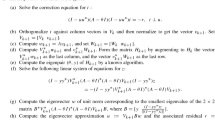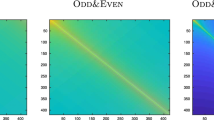Abstract
The LLL algorithm, introduced by Lenstra et al. (Math Ann 261:515–534, 1982), plays a key role in many fields of applied mathematics. In particular, it is used as an effective numerical tool for preconditioning the integer least-squares problems arising in high-precision geodetic positioning and Global Navigation Satellite Systems (GNSS). In 1992, Teunissen developed a method for solving these nearest-lattice point (NLP) problems. This method is referred to as Lambda (for Least-squares AMBiguity Decorrelation Adjustment). The preconditioning stage of Lambda corresponds to its decorrelation algorithm. From an epistemological point of view, the latter was devised through an innovative statistical approach completely independent of the LLL algorithm. Recent papers pointed out some similarities between the LLL algorithm and the Lambda-decorrelation algorithm. We try to clarify this point in the paper. We first introduce a parameter measuring the orthogonality defect of the integer basis in which the NLP problem is solved, the LLL-reduced basis of the LLL algorithm, or the \(\Lambda \)-basis of the Lambda method. With regard to this problem, the potential qualities of these bases can then be compared. The \(\Lambda \)-basis is built by working at the level of the variance-covariance matrix of the float solution, while the LLL-reduced basis is built by working at the level of its inverse. As a general rule, the orthogonality defect of the \(\Lambda \)-basis is greater than that of the corresponding LLL-reduced basis; these bases are however very close to one another. To specify this tight relationship, we present a method that provides the dual LLL-reduced basis of a given \(\Lambda \)-basis. As a consequence of this basic link, all the recent developments made on the LLL algorithm can be applied to the Lambda-decorrelation algorithm. This point is illustrated in a concrete manner: we present a parallel \(\Lambda \)-type decorrelation algorithm derived from the parallel LLL algorithm of Luo and Qiao (Proceedings of the fourth international C\(^*\) conference on computer science and software engineering. ACM Int Conf P Series. ACM Press, pp 93–101, 2012).


Similar content being viewed by others
References
Agrell E, Eriksson T, Vardy A, Zeger K (2002) Closest point search in lattices. IEEE Trans Inf Theory 48:2201–2214
Akhavi A (2003) The optimal LLL algorithm is still polynomial in fixed dimension. Theor Comput Sci 297:3–23
Chang X, Yang X, Zhou T (2005) Mlambda: a modified Lambda algorithm for integer least-squares estimation. J Geod 79:552–565
de Jonge PJ (1998) A processing strategy for the application of the GPS in networks. PhD dissertation 46. Netherlands Geodetic Commission, Delft
Gama N, Nguyen PQ (2008) Predicting lattice reduction. In: Proceedings of Eurocrypt 2008. LNCS 4965, Springer, pp 31–51
Grafarend EW (2000) Mixed integer-real valued adjustment (IRA) problems. GPS Solut 4:31–45
Jazaeri S, Amiri-Simkooei AR, Sharifi MA (2012) Fast integer least-squares estimation for GNSS high dimensional ambiguity resolution using lattice theory. J Geod 86:123–136
Lannes A (2001) Résolution d’ambiguïtés entières sur graphes interférométriques et GPS. CR Acad Sci I-Math 333:707–712
Lannes A, Gratton S (2008) QR implementation of GNSS centralized approaches. J GPS 7:133–147
Lannes A, Gratton S (2009) GNSS networks in algebraic graph theory. J GPS 8:53–75
Lannes A, Teunissen PJG (2011) GNSS algebraic structures. J Geod 85:273–290
Lenstra AK, Lenstra HW, Lovász L (1982) Factorizing polynomials with rational coefficients. Math Ann 261:515–534
Luo L, Qiao S (2011) A parallel LLL algorithm. In: Proceedings of the fourth international C\(^*\) conference on computer science and software engineering. ACM Int Conf P Series. ACM Press, pp 93–101
Nguyen PQ, Stehlé D (2009) An LLL algorithm with quadratic complexity. SIAM J Comput 39:874–903
Schnorr CP (1987) A hierarchy of polynomial time lattice reduction algorithms. Theor Comput Sci 53:201–224
Schnorr CP (2006) Fast LLL-type lattice reduction. Inf Comput 204:1–25
Schnorr CP (2011) Accelerated slide- and LLL-reduction. ECCC 18:50
Teunissen PJG (1993) Least-squares estimation of the integer GPS ambiguities (Invited Lecture). P IAG Section IV “Theory and Methodology”, Beijing, China. Also, in LGR Series, No 6
Teunissen PJG (1995) The least-squares ambiguity decorrelation adjustment: a method for fast GPS integer ambiguity estimation. J Geod 70:65–82
Teunissen PJG, Kleusberg A (1998) GPS for Geodesy, 2nd edn. Springer, Berlin
Verhagen S, Teunissen PJG (2006) New global satellite system ambiguity resolution methods compared to existing approaches. J Guid Control Dynam 29:891–991
Xu PL (2001) Random simulation and GPS decorrelation. J Geod 75:408–423
Xu PL (2012) Parallel Cholesky-based reduction for the weighted integer least-squares problem. J Geod 86:35–52
Acknowledgments
The author is very grateful to Jean-Louis Prieur for helpful discussions.
Author information
Authors and Affiliations
Corresponding author
Rights and permissions
About this article
Cite this article
Lannes, A. On the theoretical link between LLL-reduction and Lambda-decorrelation. J Geod 87, 323–335 (2013). https://doi.org/10.1007/s00190-012-0601-4
Received:
Accepted:
Published:
Issue Date:
DOI: https://doi.org/10.1007/s00190-012-0601-4




